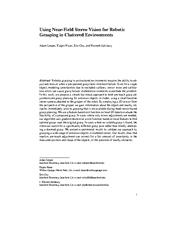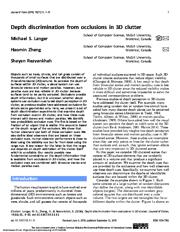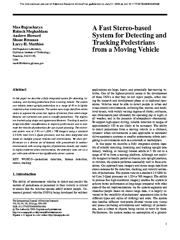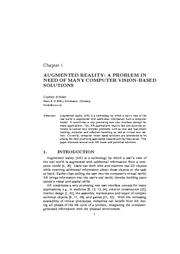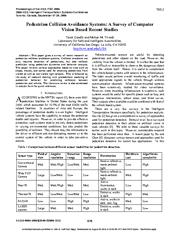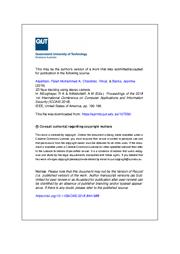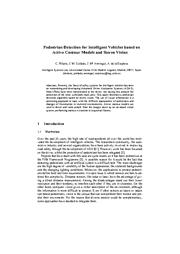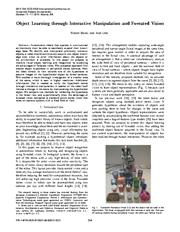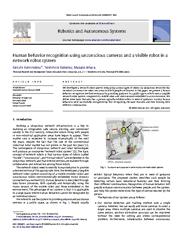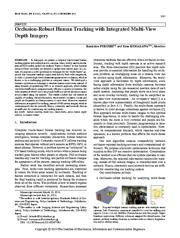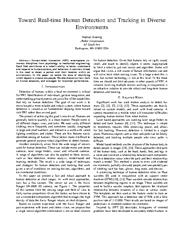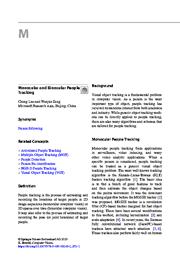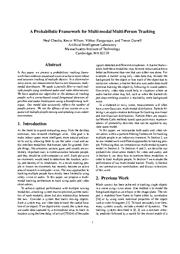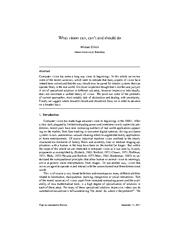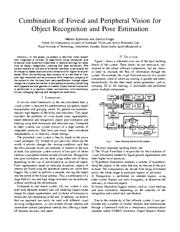A copy of this work was available on the public web and has been preserved in the Wayback Machine. The capture dates from 2011; you can also visit the original URL.
The file type is application/pdf.
Filters
Using Near-Field Stereo Vision for Robotic Grasping in Cluttered Environments
[chapter]
2014
Springer Tracts in Advanced Robotics
By employing a 3D sensor from the perspective of the gripper we gain information about the object and nearby obstacles immediately prior to grasping that is not available during head-sensor-based grasp ...
In this work, we propose a simple but robust approach to both pre-touch grasp adjustment and grasp planning for unknown objects in clutter, using a small-baseline stereo camera attached to the gripper ...
Acknowledgments This work was financially supported in part by Disney Research.
Using Near-Field Stereo Vision for Robotic Grasping in Cluttered Environments ...
doi:10.1007/978-3-642-28572-1_18
fatcat:5j7ub7wyanewxbfdfrcywuofhq
Depth discrimination from occlusions in 3D clutter
2016
Journal of Vision
Here, we present a set of depth discrimination experiments that examine depth from occlusion cues in 3D clutter, and how these cues interact with stereo and motion parallax. ...
Our results provide new fundamental constraints on the depth information that is available from occlusions in 3D clutter, and how the occlusion cues are combined with binocular stereo and motion parallax ...
Acknowledgments This research was supported by a Team Grant from FQRNT (Fonds québécois de la recherche sur la nature et les technologies). ...
doi:10.1167/16.11.11
pmid:27618514
fatcat:ozsiliztwndhzamv5aoyzb6eva
A Fast Stereo-based System for Detecting and Tracking Pedestrians from a Moving Vehicle
2009
The international journal of robotics research
The system uses range data from stereo vision to segment the scene into regions of interest, from which shape features are extracted and used to classify pedestrians. ...
In this paper we describe a fully integrated system for detecting, localizing, and tracking pedestrians from a moving vehicle. ...
Acknowledgments The research described in this publication was carried out at the Jet Propulsion Laboratory, California Institute of Technology, with funding from the Army Research Lab (ARL) under the ...
doi:10.1177/0278364909341884
fatcat:gpbmysqt5jc6rjkbwgbflaqh5y
Augmented Reality: A Problem in Need of Many Computer Vision-Based Solutions
[chapter]
2000
Confluence of Computer Vision and Computer Graphics
Augmented reality (AR) is a technology by which a user's view of the real world is augmented with additional information from a computer model. ...
Yet, AR applications require fast and accurate solutions to several very complex problems, such as user and real object tracking, occlusion and reflection handling, as well as virtual user motion. ...
Acknowledgments Most of this work was conceived and developed while the author was at the Fraunhofer Project Group for Augmented Reality at ZGDV. ...
doi:10.1007/978-94-011-4321-9_15
fatcat:nwkflryw45eobit666sgsbbpmm
Pedestrian collision avoidance systems: a survey of computer vision based recent studies
2006
2006 IEEE Intelligent Transportation Systems Conference
The paper reviews various approaches based on cues such as shape, motion, and stereo used for detecting pedestrians from visible as well as non-visible light sensors. ...
The literature review is also condensed in tabular form for quick reference. ...
However, separating objects from background clutter is a difficult problem for computer vision. Furthermore, vision becomes less effective during dark conditions. ...
doi:10.1109/itsc.2006.1706871
dblp:conf/itsc/GandhiT06
fatcat:woolpbxkjvhmbl2stjhdnsuway
3D Face Tracking Using Stereo Camera
2018
2018 1st International Conference on Computer Applications & Information Security (ICCAIS)
Numerous approaches employ machine vision in analyzing the images obtained from stereo cameras. ...
Researchers have investigated the use of stereo cameras in tracking and analyzing moving images. ...
doi:10.1109/cais.2018.8441988
fatcat:sin4fjamdbfg3etvrovcoi73zm
Pedestrian Detection for Intelligent Vehicles Based on Active Contour Models and Stereo Vision
[chapter]
2005
Lecture Notes in Computer Science
Active contour models are used to detect and track people from the images taken by an on-board vision system, performing contour extraction in sequential frames. ...
The use of visual information is a promising approach to cope with the different appearances of pedestrians and changes of illumination in cluttered environments. ...
Acknowledgements This work was supported in part by the Spanish government under CICYT grant TRA2004-07441-C03-01. ...
doi:10.1007/11556985_70
fatcat:joalulwlanh2pf4b2fghmlfxza
Object Learning through Interactive Manipulation and Foveated Vision
2013
2013 13th IEEE-RAS International Conference on Humanoid Robots (Humanoids)
We compare two methods for validating the hypotheses in the foveal view and experimentally show the advantage of foveated vision compared to standard active stereo vision that relies on camera systems ...
This enables a more thorough investigation of a smaller area of the scene, which is seen in higher resolution. ...
We compared different methods for validating the hypotheses in the foveal view and showed the advantages of foveal vision compared to to the standard active stereo vision with a fixed field of view for ...
doi:10.1109/humanoids.2013.7029981
dblp:conf/humanoids/BevecU13
fatcat:i42vlapq3fa4hltymdrouzf6py
Human behavior recognition using unconscious cameras and a visible robot in a network robot system
2008
Robotics and Autonomous Systems
In this paper, we present a human behavior recognition method necessary for providing guidance in a public space, which uses a tangible network robot system composed of a mobile robot and vision sensors ...
We define some basic features that a person typically exhibits when in need of guidance. ...
Mittal et al. [10] developed a system that is capable of segmenting, detecting, and tracking multiple people in a cluttered scene using multiple synchronized surveillance cameras located far away from ...
doi:10.1016/j.robot.2008.06.004
fatcat:3tj7f2wcobcv3kjrkvjvrfvhpq
Occlusion-Robust Human Tracking with Integrated Multi-View Depth Imagery
2014
IEICE transactions on information and systems
The results confirm that our system is capable of tracking cluttered scenes in which severe occlusion occurs and people are frequently in close proximity to each other. ...
Kenichiro FUKUSHI †a) and Itsuo KUMAZAWA † †b) , Members SUMMARY In this paper, we present a computer vision-based human tracking system with multiple stereo cameras. ...
Low visibility in cluttered scenes can also cause tracking mismatches. ...
doi:10.1587/transinf.2014edp7081
fatcat:i2nrkn7p3jcpvj5c3ewc7qyyi4
Toward real-time human detection and tracking in diverse environments
2007
2007 IEEE 6th International Conference on Development and Learning
In this paper we tackle the issue of identifying which objects in a scene are people. We also discuss current work on human detection, and strategies for improved performance. ...
Human-robot interaction (HRI) encompasses numerous disciplines from psychology to mechanical engineering. ...
These approaches find parts of the human body, such as the head, hands, feet, and legs in a scene and construct a relationship between each component. ...
doi:10.1109/devlrn.2007.4354077
fatcat:ob6wrbfbdfaorb7gvbghp4xrfq
Monocular and Binocular People Tracking
[chapter]
2020
Computer Vision
Definition People tracking is the process of estimating and recording the locations of target people in 2D image sequences (monocular computer vision) or 3D spaces over time (binocular computer vision) ...
It may also refer to the process of estimating and recording the pose (or joint locations) of target people. ...
Usually, depth information can be estimated from a pair of stereo images. ...
doi:10.1007/978-3-030-03243-2_872-1
fatcat:xbmokx7cxfeezfsnhfivby2qae
A Probabilistic Framework for Multi-modal Multi-Person Tracking
2003
2003 Conference on Computer Vision and Pattern Recognition Workshop
In this paper, we present a probabilistic tracking framework that combines sound and vision to achieve more robust and accurate tracking of multiple objects. ...
In a cluttered or noisy scene, our measurements have a non-Gaussian, multimodal distribution. We apply a particle filter to track multiple people using combined audio and video observations. ...
These tracking methods can be very effective in simple scenes where only one object is present. Some tracking systems build spatio-temporal representations of moving regions in a scene. ...
doi:10.1109/cvprw.2003.10099
dblp:conf/cvpr/CheckaWRD03
fatcat:d53o7glqdvc7fdplx333jex2lm
What Vision Can, Can't and Should Do
[chapter]
2014
Cognitive Systems Monographs
A set of specialised solutions in different sub areas, however impressive individually, does not constitute a unified theory of vision. ...
In this article we review some of the recent successes, which seem to indicate that many aspects of vision have indeed been solved and that the way should now be paved for robotic systems that can operate ...
But the vivid impression of being situated in a 3D scene does not suffer significantly when being deprived of stereo vision. ...
doi:10.1007/978-3-319-06614-1_9
fatcat:anzjef4ipfcy3g5by7etefokui
Combination of foveal and peripheral vision for object recognition and pose estimation
2004
IEEE International Conference on Robotics and Automation, 2004. Proceedings. ICRA '04. 2004
In this paper, we present a real-time vision system that integrates a number of algorithms using monocular and binocular cues to achieve robustness in realistic settings, for tasks such as object recognition ...
, tracking and pose estimation. ...
The binocular stereo-head used is shown in Figure 2 . ...
doi:10.1109/robot.2004.1302532
dblp:conf/icra/BjorkmanK04
fatcat:fzxhivfcuje4zm34glfttjnkyu
« Previous
Showing results 1 — 15 out of 2,151 results

